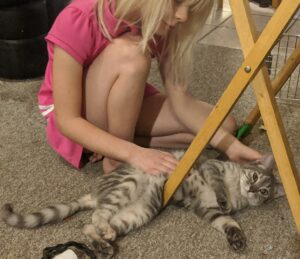Why Cats?
I love cats. Cats are regal, majestic creatures. They defy the laws of science by filling any container they curl up into. They purr, and rub on you, and curl up on your lap to snuggle. I have had cats from the time I was small. I cannot remember meeting a cat I didn’t like, though I’m sure I have.
I once saw a meme that made me laugh out loud. It said:
“What if the Internet is filled with cats because dog people go outside?”

So, if you’re here on our website, then you are obviously a cat person.
While that may not be true, it is true that if you follow Pet Harmony, you probably care a lot about your pet. You might have a pet whose behavior puzzles you. You may feel frustrated by the behaviors your animal is displaying. I promise to relate my experience with cats to dogs- and to other species, as well.
Cats get a bad reputation. I have heard many people describe cats as jerks. They’re not loyal like dogs. They make their own decisions. They never consider what you need. They’re independent, and they don’t really need us. Cats are lazy and prefer humans to dote on them like the feline gods they are!
After getting my first two dogs, and becoming a dog trainer, I’ve met many people and dogs. Often, people are happy with their dogs, only wanting to prevent future problems with a new dog. Just as often, however, I’ve run into people who are frustrated with their dog’s behaviors. Since I have been a dog trainer for quite a few years now, I’ve noticed a trend among people unhappy with their dogs. They tell me:
“He never listens to me.”
“She only minds when she wants to.”
“He won’t stop getting on the counter!”
“She nips at me when I try to make her do things.”
I understand those feelings. I know it is frustrating to think you got a man’s best friend, just to find they won’t listen to you, destroy your house, steal your food, or even hurt you. Those feelings are totally and completely valid. When I hear these things, what I understand from it is basically this:
Their dog is acting like a cat. Well, a stereotypical one, anyhow.
Cats Are a Lesson in Consent. (And Agency)
What I mean when I say that their dog is acting like a cat is really that their dog has opinions. Their dog has things they like and things they dislike. Their dog likes some things better than listening, especially if they don’t understand why they should listen. Dogs are very social creatures. They descend from creatures that worked together to bring down large prey. Wild felines, however, are usually pretty solitary. What that means is though both wild canids and wild felines are individuals with wants and needs, our concept of “dog-ness” includes a certain level of “clinginess” and working for its “master” (which is a strange use of words we can get into another time). We expect dogs to appease us. However, our society’s concept of “cat-ness” is usually aloof and independent.
What a cat really needs, as well as any pet, is agency and consent. Agency is the ability to have control over certain outcomes in your life. This can usually come in the form of choices given to an individual. Consent is the ability to assent to or approve of something, especially something that is happening to oneself. Each of these creates a sense of freedom in the animal. Trapped animals lash out, bite, and scratch. An animal that is given agency will feel more secure, and less likely to lash out.
Why Agency? Check out Allie’s excellent post about it, here, or read about it in Emily and Allie’s book, Canine Enrichment for the Real World.
How do I give my pet a sense of Agency?
Give them choices. That doesn’t mean that you open every door and window and take out any safety measure for your pet. It means you offer them choices that don’t endanger your pet or anyone in your home. If your cat (or dog) doesn’t like to be out when new people are over, make them a safe place to hide away from people until they leave. They may surprise you and come to observe the new person. Don’t pick them up and force them to interact. This is removing their ability to control the situation and thus limiting their choices. If you let them choose when, how, and if they want to interact, don’t be surprised if you find they are more willing to come out in the future. Conversely, if you force them to interact with someone, they may become more reclusive in the future.
When we brought home my cat, Sylphrena, she was 6 months old. My husband and daughter had limited experiences with cats, and were upset that she didn’t want to be held by them, but would (often) allow me to hold her. At first, I wasn’t sure why. After watching the way they held her, I realized why. My daughter and husband would often hold her tighter if she struggled to get away. This would result in a teenage kitty tantrum: scratches, bites, and occasionally growling. Obviously, she didn’t like it, but they couldn’t understand why she would let me hold her.
When an animal allows me to pick them up, I give them the choice to leave, by pulling my hands away, while still on level with the animal. If the animal runs away, so be it. Should they choose to stay, I try petting them and see if they settle down to snuggle. Then I can put my arms back around them. If they start to struggle again, I let them go. In this circumstance, I am both giving my pet choices, and allowing them to consent to being held (or not).
Allowing Sylphrena to feel safe by giving her the choice to leave really built her relationship with me. She knew I would let her go if she wanted, and knew she had agency if I tried to hold her. She wasn’t trapped.
I taught my family how to help her feel secure and safe by allowing her to make the choice whether she wanted to stay (or not), and over time she has become more trusting of my husband and daughter.

There are little things you can do every day to give your pet agency and let them consent:
- Petting consent tests (for any species)
- Making different textures and types of chews and toys available (for many animals)
- Sensory areas with pet-safe plants and textures your pet loves. (I will likely be making another blog specifically about this after I make one for my pets!)
- Allowing your pet the choice to move away from other people or animals (do not force them to say hello!)
- Making different textures available to scratch on for kitties
- Having multiple litter boxes available in different areas for your cat (you can even provide different litter options to see what they prefer)
Many times, if we just look at what our pet is telling us with their body language, we can see what they really need or want– and if we can safely provide them with the agency to do that thing, we can improve their quality of life– and, in most cases, our own as well. Because a content and healthy creature doesn’t feel the need to lash out.
Now What?
- Learn more about your pet’s species-specific body language, so you can tell if they like something or not.
- Find one way to allow your pet more agency in their life
- Research and prepare your home with appropriate furniture or enclosure requirements unique to your pet
- If you’re not sure where to start, try our free Facebook group, Enrichment for Pet Behavior Issues Community.
- If you now want to own a kitty, or are just looking for another, check out this article on how to prepare your home for a new kitty!
Here’s an excerpt:
Bringing home a cat is an exciting time for the family. They provide laughter, companionship, and can even teach little ones about responsibility. However, preparing your home for a kitty can bring about some uncertainties and renovations to ensure your cat is well taken care of and comfortable in your home.
To help you get started, Redfin reached out to 14 cat experts, from Seattle, WA to Ottawa, ON, including us. Here is our best advice on how to prepare your home for a kitty. Check out How to Prepare Your Home for a Kitty: 14 Tips from the Pros.

